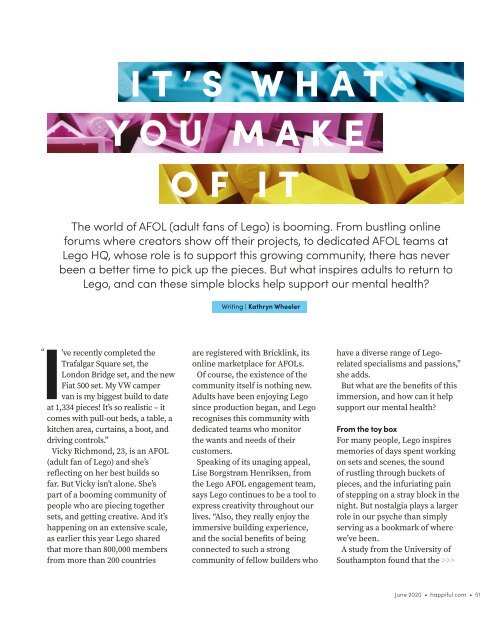Happiful June 2020
Create successful ePaper yourself
Turn your PDF publications into a flip-book with our unique Google optimized e-Paper software.
IT’S WHAT<br />
YOU MAKE<br />
OF IT<br />
The world of AFOL (adult fans of Lego) is booming. From bustling online<br />
forums where creators show off their projects, to dedicated AFOL teams at<br />
Lego HQ, whose role is to support this growing community, there has never<br />
been a better time to pick up the pieces. But what inspires adults to return to<br />
Lego, and can these simple blocks help support our mental health?<br />
Writing | Kathryn Wheeler<br />
I’ve “ recently completed the<br />
Trafalgar Square set, the<br />
London Bridge set, and the new<br />
Fiat 500 set. My VW camper<br />
van is my biggest build to date<br />
at 1,334 pieces! It’s so realistic – it<br />
comes with pull-out beds, a table, a<br />
kitchen area, curtains, a boot, and<br />
driving controls.”<br />
Vicky Richmond, 23, is an AFOL<br />
(adult fan of Lego) and she’s<br />
reflecting on her best builds so<br />
far. But Vicky isn’t alone. She’s<br />
part of a booming community of<br />
people who are piecing together<br />
sets, and getting creative. And it’s<br />
happening on an extensive scale,<br />
as earlier this year Lego shared<br />
that more than 800,000 members<br />
from more than 200 countries<br />
are registered with Bricklink, its<br />
online marketplace for AFOLs.<br />
Of course, the existence of the<br />
community itself is nothing new.<br />
Adults have been enjoying Lego<br />
since production began, and Lego<br />
recognises this community with<br />
dedicated teams who monitor<br />
the wants and needs of their<br />
customers.<br />
Speaking of its unaging appeal,<br />
Lise Borgstrøm Henriksen, from<br />
the Lego AFOL engagement team,<br />
says Lego continues to be a tool to<br />
express creativity throughout our<br />
lives. “Also, they really enjoy the<br />
immersive building experience,<br />
and the social benefits of being<br />
connected to such a strong<br />
community of fellow builders who<br />
have a diverse range of Legorelated<br />
specialisms and passions,”<br />
she adds.<br />
But what are the benefits of this<br />
immersion, and how can it help<br />
support our mental health?<br />
From the toy box<br />
For many people, Lego inspires<br />
memories of days spent working<br />
on sets and scenes, the sound<br />
of rustling through buckets of<br />
pieces, and the infuriating pain<br />
of stepping on a stray block in the<br />
night. But nostalgia plays a larger<br />
role in our psyche than simply<br />
serving as a bookmark of where<br />
we’ve been.<br />
A study from the University of<br />
Southampton found that the >>><br />
<strong>June</strong> <strong>2020</strong> • happiful.com • 51

















